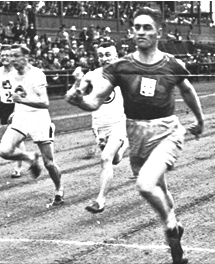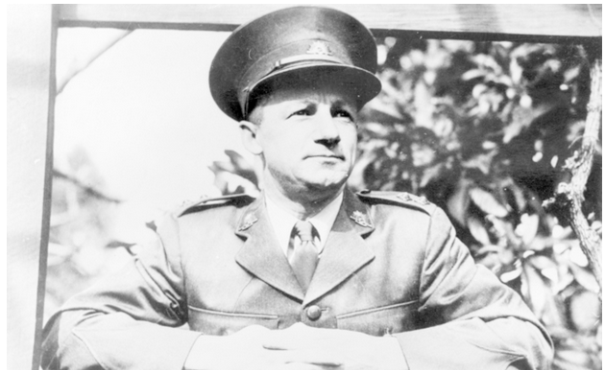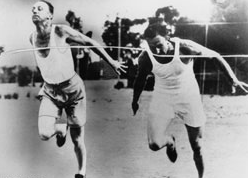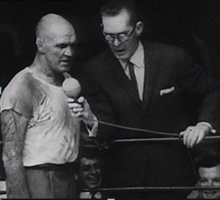
By Lance Hodgins
In 1940 the school year had almost finished when the students of Frankston High were informed that their school First XI would be playing a team from the local Army Camp. The Army team would contain two Test cricketers – none other than the legendary Don Bradman and the spin bowler “Chuck” Fleetwood-Smith. Both were officers at the Army School of Physical Training in Frankston.
Earlier that year the Army had taken over the Church of England Boys’ Society camp in Overton Road, near Frankston’s Mile Bridge.

Their PT School was based on the British Army School at Aldershot, where different sports were played in daylight hours followed by studies of anatomy, physiology and hygiene in the evening.

Conducting the various activities were officers with incredible sporting credentials. The Superintendent was Captain “Slip” Carr, a former Rugby International and champion athlete, who had been the first to carry the Australian flag at an Olympic Games – Rome in 1924. Amongst the staff officers were several League footballers, international rugby players, professional wrestlers and boxers, and champion cyclists.
The school children of Frankston were well acquainted with this array of sporting talent. In July 1940 hundreds of them were spectators when the Army School gave a display of physical training drills and athletic contests in Frankston Park.
Frankston was abuzz when news broke in October that “The Don” – Lieutenant Donald Bradman – would be joining the PT staff of the Army School. Bradman had joined the RAAF who dithered for months until the Army arranged a transfer, made him an officer, and offered him a position as a physical training supervisor. His arrival in the small bay-side town was eagerly awaited.

To any boy in the late 1930’s, Bradman was the greatest Australian alive. In 1930 he had toured England and brought home the Ashes to a hero’s welcome. Three double centuries and two triple centuries made the 22 year-old’s name a household word.
Every Aussie shuddered at the “Bodyline Series” of 1932 which saw the Ashes handed back to England. Australians were incensed and could hardly wait to tour England and have their revenge. Two years later Bradman’s team regained the Ashes for the remainder of the decade.

In 1936-7 every Melbourne schoolboy would have wished they were at the MCG to see his 270 runs in what many experts regard as his classiest Test performance.
After a successful tour of England in 1938, Bradman was playing in South Australia when war broke out and put a halt to international cricket.

When Bradman arrived in Frankston, however, there would be even less cricket. Although the District Cricket regulations were changed to allow clubs to play soldiers in their local camps, Bradman declared he would focus on his physical education course and only play in a few service games.
Within a week, he was playing against the Somers RAAF training camp when he was run out for 18. On November 14 1940, Frankston was treated to a half holiday to watch a “celebrity” match between the Army School and the councillors of the Shire of Frankston and Hastings. Bradman reached 102 before being bowled by a 20 year-old clerk named Richard Ham.
Bradman became very selective in his public appearances. He ran in the Services sprint at the MCG in late November after having declared the Oath of Allegiance on behalf of all servicemen. There was also a “Fags fund” game against the Metropolitan Fire Brigade to raise funds for the forces (2/6 per run – Bradman scored 109).

But it was the game at the Cranbourne Road oval on Monday 9 December that the Frankston folk – and the High School boys – were looking forward to the most. There was quite a crowd assembled in the grandstand – built five years earlier from one of those used for the World Scout Jamboree in the scrub of South Frankston. There was also a new turf wicket which had been used for the first time the previous week by two Frankston teams.
The Captain of the Frankston High team, Keith Allen, won the toss and decided to send in the Army School. Splendid bowling from Pearcedale lad Geoff Tallents kept the Army on the defensive and wickets fell quickly. Rugby champion Max Carpenter, a Wallaby in the 1939 touring side, went for a duck.

Much excitement was generated when Bonnie Muir walked out to bat. Bonnie was world famous as a professional wrestler and his large frame intimidated the high school boys. Not so Tallents, who served it up to him well and he was caught by young John Langman for 3.
In no time Tallents collared two more scalps – Boddington and Jones – the latter a big “V” footballer and fresh off back-to-back premierships for Melbourne.
Bradman, however, began to open his shoulders and he gave the students “an hour of leather hunting” in a brilliant masterclass. He hit one six and nine fours to reach 86 before he was caught by captain Keith Allen from the bowling of Les Sheeran.

The crowd cheered Sheeran as much as they did “The Don”. A member of a cricket and football dynasty from Merricks, he was about the same size as the diminutive Bradman, as nimble on his feet, and just as competitive.
Tallents continued to attack and took the wickets of Carr, Tanner and Beddome for only 25 more. Warrant Officer Fleetwood-Smith then strode onto the field to a huge roar from the crowd. “Chuck” was famous for having set up the retention of the Ashes in 1937 when he dismissed the leading English batsman Wally Hammond with the “ball of the century”. Thousands of spectators had gathered outside the pavilion to chant his name.
Fleetwood-Smith’s eccentricity had amused cricket fans. Off-field his good looks appealed to the ladies. On the field he would imitate bird calls (magpies and kookaburras), practice his golf swings and shout encouragement to his favourite VFL team in an imaginary match. He never took his batting seriously and on this day he was bowled by Tallents for 16. The tail end fell away quickly and the Army finished with a total of 144.
When they came to bat, the High School boys were clearly overawed and the first three – Pollie, Tallents and Nathan – each fell for a duck. Brown top-scored with a miserly 11 and their total was only 34. The follow-on was activated and the High School boys batted again. This time around, Pollie made 24, Tallents a creditable 61 and the total was 118 before play was declared over for the day. Fleetwood-Smith had been the wrecking ball, taking 8/42.
Regardless of the score, the main result of the match was always going to be a memorable one: a dozen High School boys were given an experience they would cherish for the remainder of their lives.
Most of the Army team rose through the ranks and saw out the war. Gordon Jones became a life member of Melbourne FC and went to live in Perth. “Slip” Carr retired and watched his son, Edwin Jr., compete in the 1952 Helsinki Olympics. Jack Beddome, a former champion badminton player, became President of the SA Association and restarted that sport after the war.
Bonny Muir stayed in the army until 1945, rising to Captain as an unarmed combat instructor. After few years in the ring, he became a referee in the years when television popularised professional wrestling. Outside the ring, he remained a quiet and well spoken man, a wide reader and fluent in French.
Neither Fleetwood-Smith nor Bradman lasted long in the army, both being classed as medically unfit.
Fleetwood Smith was discharged in February 1941. After the war he played a season for Melbourne CC but his life was in free-fall. Divorced, jobless, alcoholic and homeless, by the 1960’s he was sleeping on the banks of the Yarra within sight of the MCG. He was saved from obscurity by influential fans but died within two years.
Bradman was taken off active duty in April 1941 suffering severe back muscle and eyesight problems. He spent the war years recovering, wondering if he would ever play cricket again. He did return to first class cricket as captain of the “Invincibles” – the unbeaten Test team which toured England in mid-1948. Although some observed that his powers were waning, he hit 11 centuries on this tour and was knighted the following year.
The star of the High School match, Geoff Tallents, was a brilliant all-round athlete. He played football for Pearcedale and cricket for Frankston as a 16 year-old. Geoff enlisted in the AIF and then transferred to the RAAF and, after his initial training at Somers, he saw out the war overseas as a Flight-Sgt.

Team captain Keith Allen and opener Geoff Pollie also joined the RAAF. Keith, from Dromana, was killed in 1944 when his Stirling aircraft crashed and burned, shot down by anti-aircraft fire along the French coast near Bordeaux. Geoff, whose father was at Flinders Naval Depot, was a Pilot Officer attached to the RAF in India. In 1945 his Dakota aircraft had trouble just after takeoff and crashed into a mangrove swamp in Burma, killing all on board.
Fifteen year-olds Bob Stone (Somers) and Jack Langman (Crib Point) not only shared a place on the High School team but, after their war service, they were teammates in their own “Invincibles” team. Both brilliant footballers, they played alongside the great John Coleman in the Hastings triple premiership teams of the late 1940’s. Bob won several Peninsula league best and fairests and had a stint with Melbourne in the VFL. Jack gave a lifetime of community service to several sporting organisations and local government.
The schoolboy who bowled to Bradman on that famous day, Les Sheeran, maintained his sporting involvement after the war and was a regular star for Balnarring in both cricket and football.
The Army PT School continued with great success at Frankston until 1944 when it was transferred to NSW and the Overton Road property reverted to being a Church of England Camp.
The Cranbourne Road oval served as the playing fields for Frankston High until the school moved to Towerhill Road almost twenty years later. Little had changed by then – although the grandstand was burned down in 1948 and the Frankston Cricket Club had moved elsewhere.
Today the site is totally covered by the Peninsula Aquatic Recreation Centre.
What did remain, however, was the memory of the day when the Frankston High boys faced “The Don”.





